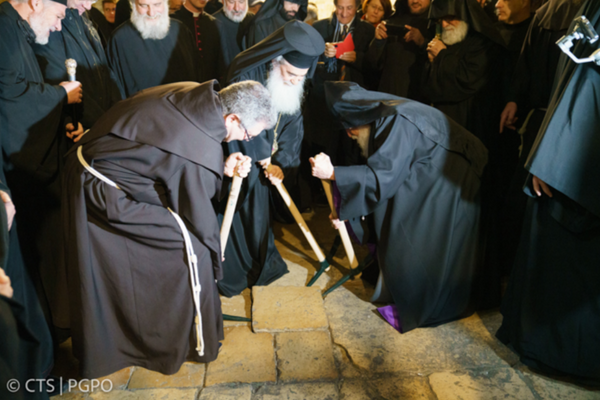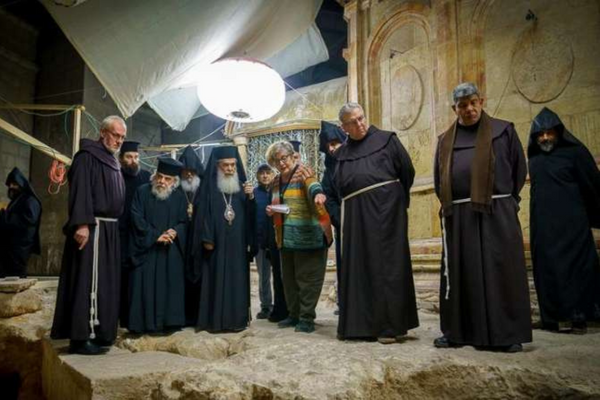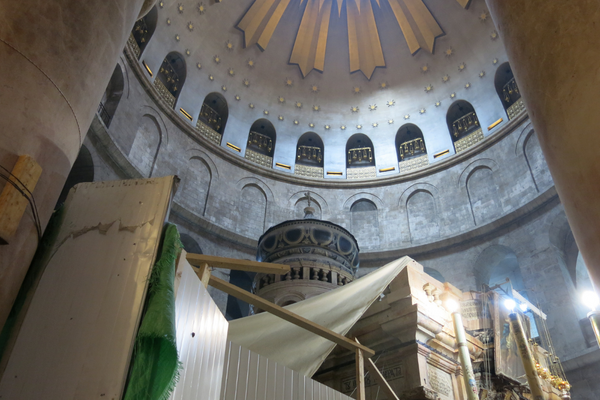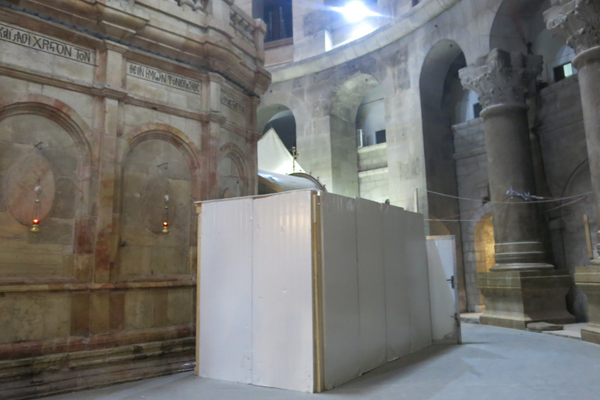Many will remember the famous photograph taken just over nine months ago in the Anastasis, the heart of the Basilica of the Holy Sepulchre. The image (photo 1) portrays the heads of the Greek Orthodox, Latin Catholic and Armenian Apostolic Churches lifting a stone of the ancient floor with pickaxes. The gesture marked the beginning of conservation and restoration work inside the most important Basilica of Christianity.
The leaders of the Holy Place in Jerusalem have met several times in recent months with regular inspections to make important decisions together and keep up to date on the state of the art of the restoration work. In this regard, the Custody of the Holy Land has recently published a statement written by Prof. Francesca Romana Stasolla, director of the excavation works carried out by the Department of Sciences of Antiquity of the University of Rome La Sapienza.

The point on the work according to Prof. Stasolla
Entering the Holy Sepulchre of Jerusalem it is evident the great restoration operation that continues unabated day and night. Large white sheets, numbered marble slabs, signs of “Work in progress” hanging from the columns and a bustle of archaeologists, workers, technicians and architects. Despite this, the orderly coexistence of excavation activities and pilgrims who, attentive and curious, line up next to the Edicule as has been the case for hundreds of years, is striking.
“The excavations began in May 2022 and […] they are concentrating in the southern portion of the Rotonda» explains Professor Stasolla on the occasion of the last visit of the leaders of the three Communities on 11 January 2023 to the archaeological site of the Sepulchre. The pilgrims who are going to the Basilica in these days will notice the work concentrated in the southern area of the Rotonda dell’Anastasis, so much so that the Copts had to install a temporary prefabricated chapel for the performance of their service. Faithful and pilgrims, however, have nothing to fear: the excavation work was immediately divided into ten distinct areas so as to hinder as little as possible the flow of visitors to the holy place and the conduct of the liturgies.
In her statement, Prof. Stasolla explains that: “the work takes place in a continuous cycle, day and night, and the group of archaeologists operating in Jerusalem makes use of the remote support of the rest of the team located in Rome, where the processing of the materials produced takes place, which is carried out in real time”.

Old and new discoveries
The works are concentrated on an area of 1,000 m² and there are numerous discoveries by archaeologists, who however prefer not to reveal immediately. It can be communicated that the excavations below the nineteenth-century aedicule have found the remains of two floor phases in opus sectile (ie the union of marble tesserae to compose geometric shapes) and a circular floor around the entire burial area that coincides with the oldest representations of the aedicule.
These important excavations are also allowing us to explore again an area investigated in 1974 by the architect Charles Coüasnon and documented by the Franciscan friar and archaeologist Virgilio Corbo. In this way, the discoveries of the past can be confirmed, detailed and updated. The magazine “Holy Land” writes in this regard that the research in the subsoil of the Holy Sepulchre will probably cover a span of 26 months.


Looking forward to new developments
The director of the works concludes the point on the excavations by stating that it is necessary “to continue the archaeological investigations and the study of the materials found, so as to be able to point out sequences and chronologies and therefore propose philologically reliable reconstructions”.
So we just have to wait for new developments on the state of the work of the Basilica, certain of the importance of this great project, as Friar Francesco Patton had affirmed at the beginning of March 2022: “Cooperation in restoration work takes on a different meaning, because this is the place where Jesus becomes the cornerstone of the Church.”
by:proterrasancta






